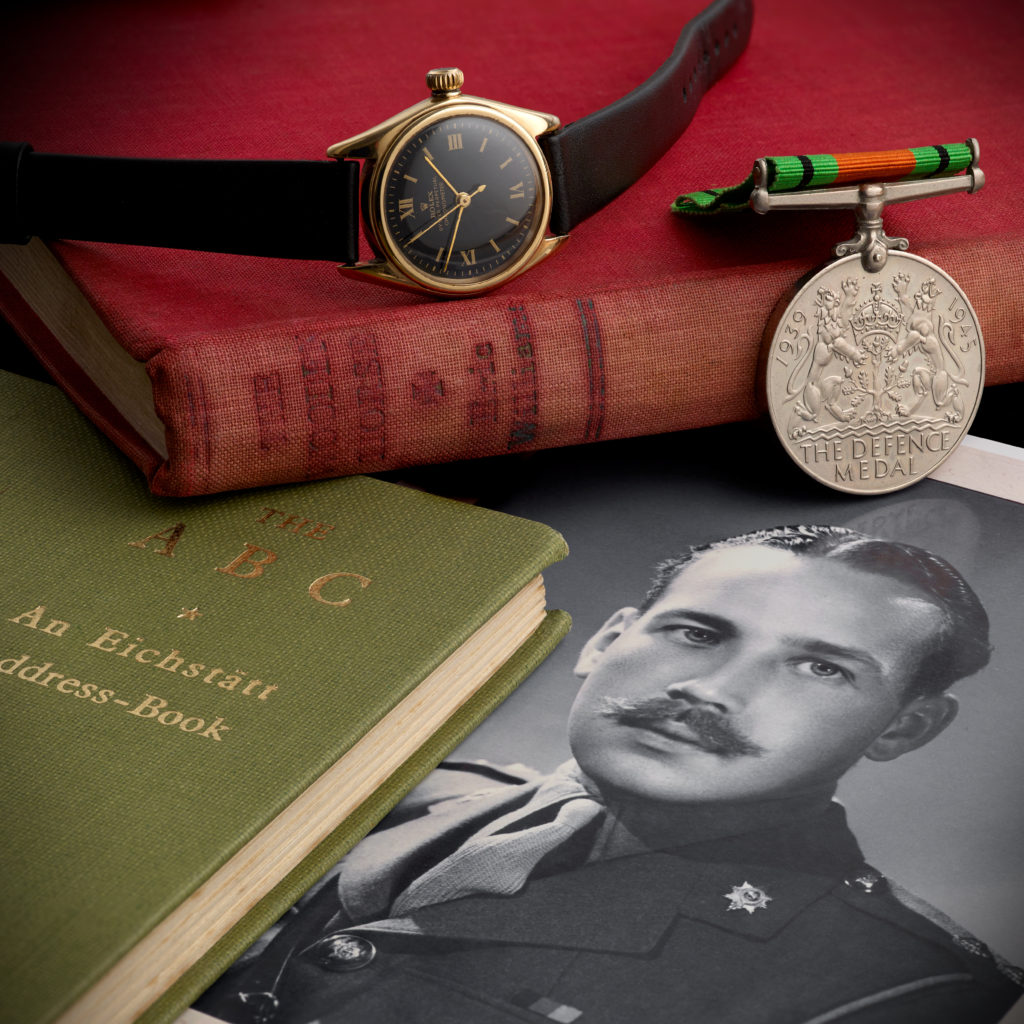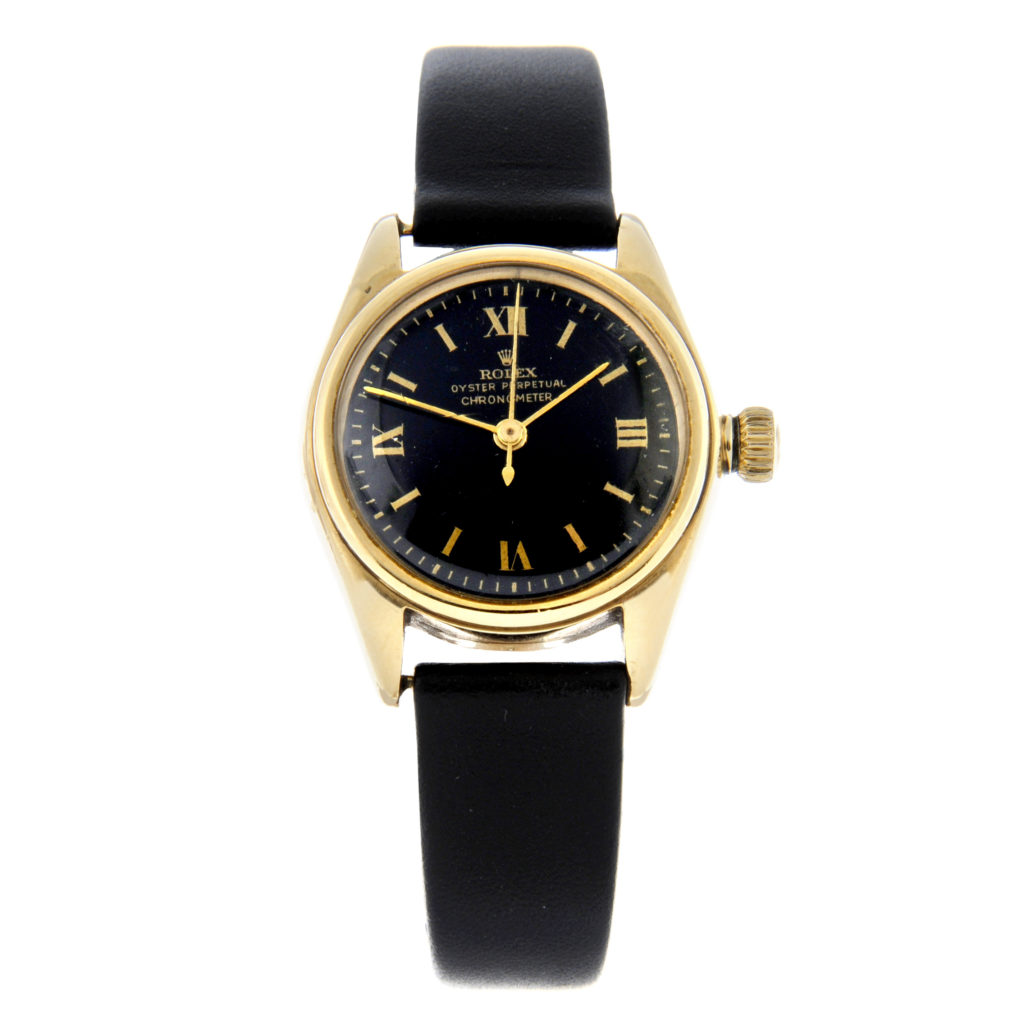A Rolex given to a British Army lieutenant who was captured as a prisoner of war at the Battle of Dunkirk was a highlight of our watch auction this week. It sold for a full price of £4,593.60 including fees (£3,600 hammer price).
We sold the watch sold accompanied by a defence medal, images of the lieutenant and two books.
C.M.A. Whitaker
Charles Maurice Anthony (Tony) Whitaker (1918 – 1969), of the Worcestershire Regiment, was commissioned into the Territorial Army in the 1930s.

Captured inland during the Battle of Dunkirk in 1940, Whitaker was given a Rolex Oyster Perpetual wristwatch while he was a prisoner of war. He was incarcerated at Oflag VII-B, a prisoner-of-war camp in Bavaria.
Nearly 80 years later, the watch has resurfaced. With an estimate of £2,800 – £3,600, it was Lot 171 in our Luxury Watch Sale, an auction in Birmingham’s Jewellery Quarter on Monday 21st March.
Tony Whitaker, who lived in Pershore, came from a family of Worcestershire landowners. He joined the Worcestershire Regiment in 1937 and was second lieutenant. He was reported missing after the Battle of Dunkirk in May 1940.
Whitaker was captured whilst holding a bridge for men retreating to the beaches. It was from here that the second lieutenant was missing for a year, presumed dead by his family.
The Prisoner of War Camps
He moved between several prisoner-of-war camps in Poland and Germany for the next five years. The camps included Stalag Luft III and Oflag VII-B – where he was given the watch.
Whilst held captive at Stalag Luft III, Whitaker made friends with a flight lieutenant, Eric Williams, who penned the book ‘The Wooden Horse’. A signed copy of which was included with this lot.
It was at Oflag VII-B, a camp for officers in Bavaria, where Whitaker received the Rolex. Rolex and Hans Wilsdorf sent these watches to officers as a morale boost. The prisoners paid for them later on returning to Great Britain. It is believed that British soldiers had to request a watch by letter.
At the closing stages of the war when leaving the camp, Whitaker was injured in a friendly fire incident in 1945. He sustained a shrapnel wound in his leg. As a result, he had to spend months after the war in hospital on the Isle of Wight.
Whitaker continued to wear the Rolex in later life. He worked in multiple jobs after the war, including a Gloucester engineering firm.
Charles Maurice Anthony (Tony) Whitaker died in 1969.
The Prisoner of War Watch
The Rolex was sold by Whitaker’s son, Max, 72, who lives in Bath. The watch has been worn continuously since the war and still works. It has been worn by Tony himself, Max’s late mother and briefly by Max.

We sold the watch with a signed copy of ‘The Wooden Horse’ by Eric Williams, a further book listing inmates from Oflag VII-B, a defence medal and two photos of Whitaker, including one with him wearing the Rolex.
It is not confirmed whether the defence medal was awarded to Whitaker or another individual.
Numbered 2595, the watch has a signed manual wind calibre 710. The watch has a black dial with baton and quarterly Roman numeral hour markers. This Rolex has an unsigned black leather strap and is also in great condition for its age.
Max Whitaker, who sold the watch at Fellows, said: “No one knew what happened to my dad after the Battle of Dunkirk until eventually he was listed as a prisoner of war a year later.
“He was a very social man, he loved racing and often visited Cheltenham. My dad rarely spoke to me about the war. When I was a child, he did tell me that he tried to escape the camps twice and was once recaptured outside the perimeter fence in a field of potatoes.
“My dad still managed to hold down several jobs despite suffering nervous problems after the war. His Rolex watch has been in constant use since the war and I have worn it on occasion myself in the last ten years.”
Watches for War
Does the history of military watches and their place during wartime uniforms interest you? You might like to watch this video on YouTube. We invited author and journalist Simon de Burton to share his knowledge and passion for rare watches in a talk. In this exclusive event for Fellows, he explored the history of watches used in military settings from as far back as the 19th Century to the modern day. Don Cochrane from Vertex joined us to discuss the famous WWII Dirty Dozen set of watches.
Valuations
Our valuations are free, with no obligation to sell with us. Our experts will value your item with an estimate, so you can find out what it could achieve at auction.
The process is simple, so you can get a valuation now:
Fill in a form online. In addition, you can book an appointment to visit our offices in Birmingham and London. Moreover, you can book a virtual valuation appointment.

